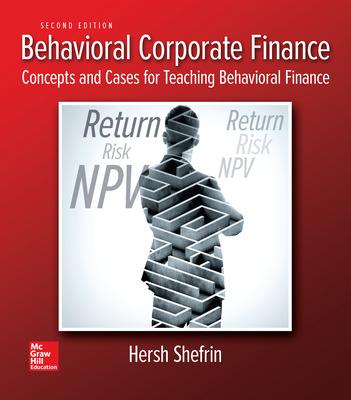Consider the issues of project budget, scope, and project timetable. Discuss the extent to which the CityCenter project reflects survey evidence discussed in the chapter
- Consider the issues of project budget, scope, and project timetable. Discuss the extent to which the CityCenter project reflects survey evidence discussed in the chapter about capital budgeting biases associated with the planning fallacy.
- Consider whether MGM faced issues in the CityCenter project that could be characterized as sunk costs, and if so, whether they exhibited behavior consistent with “escalation of commitment.”
- Compare the CityCenter project with specific projects discussed in the chapter, namely:Sony’s Chromatron, Syntex’s Enrprostil, Motorola’s Iridium, Eurotunnel’s Channel Tunnel, Boeing’s Dreamliner, and Airbus’s A380. Your discussion should indicate whether the main psychological phenomena that surfaced in each project also surfaced in the City Center project, as well as commenting on similarities and differences in the comparisons.
In 2004, the hotel casino company MGM Resorts International (MGM) (previously MGM Mirage) initiated what would later become the world’s largest private sector project. They called it CityCenter, and it would involve a 67-acre complex on the Las Vegas strip with a major casino, condominiums, hotels, shops, restaurants, and en- tertainment venues. MGM subsequently partnered with Dubai World during the construction phase.47 MGM was managed by a very experienced set of professionals, who were quite sophisticated about capital budgeting. These professionals relied heavily on DCF, en- gaged consultants to assist with cash flow forecasts, and were very detailed in their analyses about a wide range of issues, including contract cost management and availabil- ity of labor resources.
In 2004, MGM provided no official budget for Project CityCenter, but its board approved one, which the com- pany suggested would be in the vicinity of $4 billion. This amount excluded the sale of an estimated 1,650 condo- miniums, which the company envisioned would sell for about $1 billion. Thereafter, MGM referred to its budget as a moving target, raising it to $5 billion in 2005.48 MGM also added qualifying language stating: “The design, budget and schedule of Project CityCenter are still pre- liminary, however, and the ultimate timing, cost and scope are subject to risks attendant to large-scale projects.”
By March 2006, the budget for Project CityCenter had grown to $7 billion, as reported in the company’s 2005 published annual report. This figure excluded the value of underlying land and marketing costs, as well as revenues from sales of condominiums, which were forecasted to be $2.5 billion. The majority of the land value at historic cost was recorded at $40 million. Therefore, they estimated net cost to be $4.5 billion.
Jim Murren, MGM’s CFO at the time, attributed $800 million of the $3 billion increase to expected inflation, and $1.2 billion to the company’s decision to increase the number of condominiums.
The condominium decision reflected a rapidly growing real estate market. Although construction costs had been ris- ing rapidly across the United States, Murren and CityCenter President Bobby Baldwin were not concerned, with Baldwin having said: “We have a complete, nailed-down design scope.”49 In regard to building materials, MGM was creative—for example, by taking the unconventional step of making large purchases from Chinese suppliers.
The project’s primary construction contractor was the Perini Building Company. In respect to design, MGM engaged the services of the highly regarded firms Ehrenkrantz, Eckstut & Kuhn to develop the conceptual master plan for the project and Gensler as executive architect. In all, the company engaged 11 architectural firms for various projects within the overall CityCenter masterplan complex. They commissioned the renowned design architect Cesar Pelli to produce a design for the main hotel and casino building that would be “paradigm- shifting.” By their nature, paradigm-shifting projects are highly complex, and laden with uncertainties. A key risk of the project was “scope creep,” a tendency ...
Step by Step Solution
3.45 Rating (164 Votes )
There are 3 Steps involved in it
Step: 1
1 The point of this question is to help students learn to engage in thought processes associated with reference class forecasting a key feature of outside view thinking The presentation of the minicas... View full answer

Get step-by-step solutions from verified subject matter experts
100% Satisfaction Guaranteed-or Get a Refund!
Step: 2Unlock detailed examples and clear explanations to master concepts

Step: 3Unlock to practice, ask and learn with real-world examples

See step-by-step solutions with expert insights and AI powered tools for academic success
-
 Access 30 Million+ textbook solutions.
Access 30 Million+ textbook solutions.
-
 Ask unlimited questions from AI Tutors.
Ask unlimited questions from AI Tutors.
-
 Order free textbooks.
Order free textbooks.
-
 100% Satisfaction Guaranteed-or Get a Refund!
100% Satisfaction Guaranteed-or Get a Refund!
Claim Your Hoodie Now!

Study Smart with AI Flashcards
Access a vast library of flashcards, create your own, and experience a game-changing transformation in how you learn and retain knowledge
Explore Flashcards





